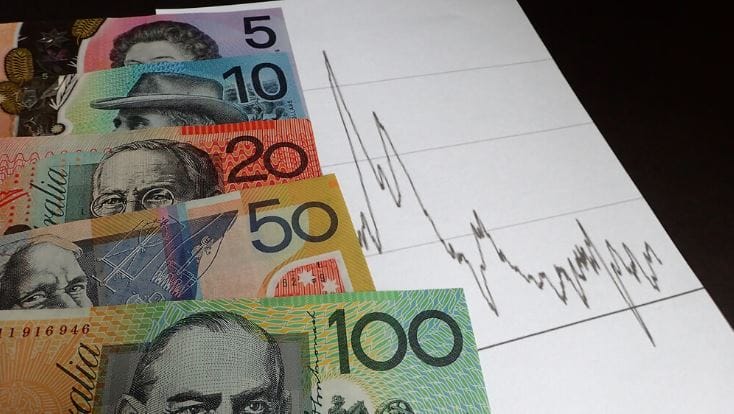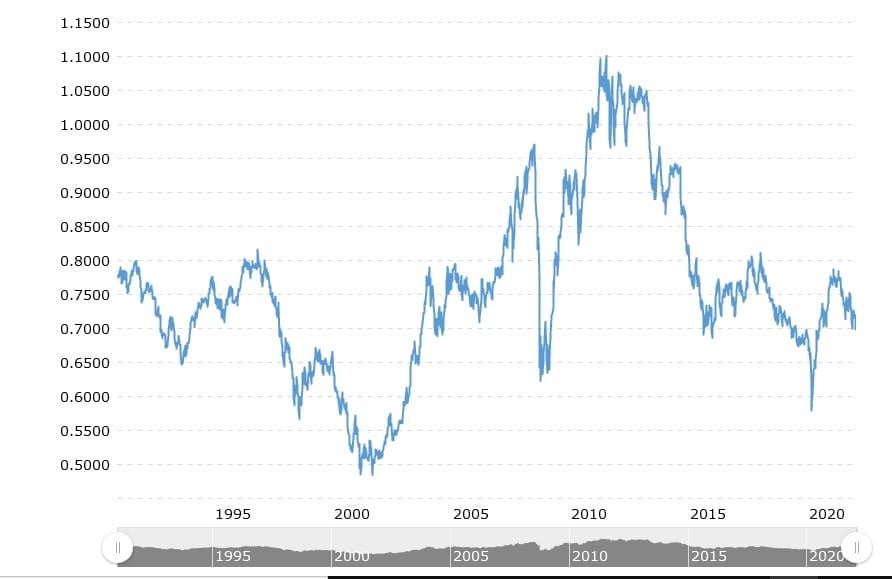AUD/USD is one of the most traded pairs on the planet. Many traders prefer to trade pairs amidst the market uncertainty.
Ah, that good ol’ AUD!
It has the same name but differs in price versus the USD.
Do you know AUD is the fifth most traded currency in the forex market?
In this guide, we’ll dig deeper into what AUD/USD holds and how you can trade it.
History of AUD/USD
Before doing any further, we want to give you a quick history lesson. So, let’s rewind the clock and talk about the history of both AUD and USD.
Before the advent of the Australian dollar in 1966, the Australian pound was the country’s currency. The Australian pound entered circulation in 1910 at the same rate as the pound sterling.
Following a currency depreciation in 1931, its value diverged from the pound sterling. As a result, the first Australian dollar paper notes were issued in 1966 in $1, $2, $10, and $20.
The USD’s origins began with the Founding Fathers’ efforts to create a national currency modeled on the Spanish silver dollar.
The new Congress approved the Coinage Act of 1792, which created the United States dollar as the country’s fundamental unit of currency. However, it adopted the gold standard in 1900 and eventually withdrew it in 1971.
Fun fact: The AUD/USD pair is called the Aussie. It is also the name of the AUD.
Exchange rate history
Now that you know the history of both AUD and USD let’s find out their exchange rate history.
The pound was devalued against the US dollar in 1967. The AUD, on the other hand, remained pegged to the USD at the rate of 1 AUD = 1.12 USD.
On October 15, 2010, the dollar hit parity with the US dollar for the first time since becoming a freely traded currency, briefly trading over $1.
The currency then traded above parity for many days in November and hovered around that level until 2011. Finally, on July 27, 2011, the dollar reached a new all-time high versus the US dollar, reaching $1.1080.
However, with the conclusion of China’s large-scale purchases of Australian commodities in 2013, the Australian dollar’s value vs. the US dollar has fallen to $0.88 as of the end of 2013.
Because Australia is the world’s largest supplier of coal and iron ore, the value of its currency is highly influenced by commodities prices. For example, oil prices fell to decade lows during the 2015 commodities slump, such as iron ore and coal.
Unsurprisingly, the Australian dollar fell precipitously. It plummeted by more than 15% versus the US dollar, reaching a low of $0.57 in March 2020. It traded at a level of $0.71 to $0.80 in 2021.
At the time of writing, AUD/USD is trading 0.9072.
Three g’s and AUD
The appeal of the AUD among forex traders is due to its three Gs: geology, geography, and government policy.
Geology has provided the corporation with many in-demand natural resources, including oil, gold, agricultural goods, diamonds, iron ore, uranium, nickel, and coal.
Geographically, the firm has positioned itself as a preferred trade partner for several fast-growing Asian nations with practically insatiable resource demands.
Government policy has resulted in relatively constant high-interest rates, a stable government and economy, a lack of currency market action, a Western attitude to business, and the rule of law that has not traditionally been customary in the area.
How to trade AUD/USD?
To trade AUD/USD, you need to open an account with the broker, deposit funds, and select AUD/USD as your pair.
If the current quote of AUD/USD is 0.9070, it indicates that one AUD is worth 0.9070 dollars. We know forex pairs comprise base and quote currencies. So, here, the base currency is AUD, and the quote currency is USD.
Let’s give an example of how you can trade the pair.
Suppose you want to go short (sell) AUD/USD at 0.9070. Then, the market starts moving in your direction, and the AUD/USD rate becomes 0.9040. So, you make a cool 30 pips profit.
Let’s say the market doesn’t go in your favor and starts declining, and the rate becomes 0.9080. In this case, you lost ten pips.
Factors affecting AUD/USD
There are a lot of factors that can affect the Aussie. Knowing them will help you understand the pair better and make your trading positions accordingly.
Interest rates
When compared to each other, the interest rate disparity between the Reserve Bank of Australia (RBA) and the Federal Reserve (Fed) will impact the value of these currencies.
When the Fed acts in open market activity to weaken the US currency, the AUD/USD pair’s value may rise. This occurs due to the Fed’s operations, which bring more US dollars into bank circulation, increasing the supply of US dollars and putting downward pressure on the currency’s price.
Assuming no other changes occur, the Australian dollar will retain its worth, and the pair’s relative value will rise as the Australian currency strengthens compared to the US dollar.
Commodity prices
Australia produces many commodities that have a significant impact on currency values. This makes logical, though, because an Australian corporation will need to be paid in Australian dollars.
For example, copper producers in Australia who sell to other nations worldwide will want Australian dollars to be paid.
As a result, those importers are forced to travel to the forex markets and swap their native currency for the Australian dollar, driving up the value of that currency.
Trade relations
Like any other currency or country globally, trading connections play a role. However, Australia is so closely linked to China that it is slightly different from other countries. The state of the Chinese economy has a significant impact on the Australian economy.
Trading relations have come into play at this moment due to the trade war between the United States and China, which is causing major collateral damage to the Australian economy.
The best method to avoid is pushing the Australian dollar higher through the US dollar.
However, as demand for the different hard commodities falls, the Australian dollar will demand, as cross-border transactions halt.
Inflationary pressures
Inflationary pressures will have a significant impact on the currency, which will be true in Australia and around the world. However, if there are fears about inflation, the Aussie dollar may benefit since it is so heavily tied to gold, a hedge against inflation.
AUD/USD correlation
Because the AUD/USD is priced in US dollars, it negatively correlates with the USD/CAD, USD/CHF, and USD/JPY pairs.
Gold has a favorable relationship with the AUD/USD.
When gold rises, so does the AUD/USD. When gold falls, so does the AUD/USD. Historically, the AUD/USD has had an 80% connection to the price of gold!
What’s the best time to trade AUD/USD?
The chart below illustrates the forex trading sessions. The best time to trade AUD/USD is 1300 to 1700 GMT.
Most of the time, London and New York will be open. As a result, this four-hour session frequently comprises the day’s largest price fluctuations even though Tokyo is closed.
This offers greater profit opportunities, as spreads are often at their smallest during this period.
Strategies for AUD/USD
AUD/USD gets significant trading volume throughout the trading day. So if you want to trade the Aussie, you have to come prepared as a trader. Here are some of the strategies you can apply:
Carry trade
When making a carry trade, a trader often sells a currency with a low-interest rate while buying a higher-yielding currency.
The AUD/USD pair is a popular pair for carry trading. Thus, Australia has one of the highest interest rates among developed countries.
Based on these interest rates, you can mix and match the currencies with the greatest and lowest returns.
Carry trades work well in low volatility conditions since traders are more ready to take risks.
However, because many people are hooked to carry trades, the currency nearly never stays constant. For example, the AUD/USD exchange rate increased by over 10% between February and April 2010. The value of the AUD/USD climbed by around 70% from January 2001 and December 2007.
News trading
When news breaks, especially vital news that everyone follows, big movement is nearly always expected.
Because you know the market will move someplace, news trading is worth a shot. Your aim as a news trader is to be on the right side of the trend.
It is worth noting that, because there is so much market news, you must choose your news trading approach carefully.
While markets react to economic data from other nations, the United States is the greatest mover and most keenly monitored.
However, news from Australia and China might influence the Australian dollar, so you must keep up with them as well.
Trendline
A trendline is a diagonal line rather than a horizontal line. There are only two kinds of trends like this. A falling line indicates that the currency pair is in a downtrend, but this might be a significant reversal indicator if it manages to break above it.
On the other hand, a rising line indicates that the pair is rising. If the price manages to break below it sometimes, it may suggest that the trend has been reversed.
What trading style mostly suits AUD/USD?
Now that you know which strategies are suitable for AUD/USD, let’s find out which trading style suits the pair:
Scalping
Scalping is a trading method that seeks to benefit from little price movements, with gains on these trades made rapidly and only after the trade has proven lucrative.
Scalpers will take multiple modest profits and not run any winners to take advantage of gains as they come. The goal is to achieve a profitable trading strategy by having many winners rather than a few major winning trades.
Scalping is based on the concept of smaller exposure risk, as the real-time in the market on each transaction is fairly short, reducing the probability of an adverse occurrence driving a large move.
Day trading
Day trading is perfect for traders who want to complete a job on the same day. It is the practice of buying and selling currencies inside a single trading day, closing out trades at the end of each day, and starting over the next.
Forex day traders buy and sell various currency pairs on the same day, or sometimes multiple times on the same day, to capitalize on minor market fluctuations.
Day trading, also known as intra-day trading, is not for the inexperienced trader since it requires time, attention, devotion, and a particular attitude.
It includes making quick selections and completing many trades for a modest return each time. So, it is often regarded as the polar opposite of conventional investment methods, in which you aim to profit from market swings over a longer period.
End-of-day trading
There’s a day, and then there’s a trading strategy after the day.
A trading strategy means making trading choices extremely close to or after the markets shut. Unlike day traders, who study charts throughout the day and initiate and cancel trades as they see fit, end-of-day traders frequently trade at the close or the open.
When you place your trades towards the end of or after the trading day, you are not distracted by news, changing market prices, or day-to-day life.
End-of-day trading setups let you cut through the noise, resulting in reduced rates, and allow you to trade with a limit or stop orders. This strategy is ideal for people who wish to continue working at their current job.
Final thoughts
So now you know everything about the Aussie.
It’s important to note that news has a major impact on AUD/USD. So if you are looking to trade the pair, you gotta keep up with the news. Also, as AUD is a commodity currency, you have to look for commodity prices to trade the AUD/USD.
Most common questions asked by the forex traders about AUDUSD :
Asian market open and the US trading sessions are the best time to trade Aussie currency.
AUD/USD Sentiment is trending now – check the live AUDUSD price chart analysis here.
Yes, 30 percent of the time, the Gold and Aussie dollar follows a positive correlation. Reason – Aussie exports gold, oil, natural gas, coal, nickel and agricultural goods.
Aussie could possibly move only 40 to 70 pips per day. Support and Resistance can be drawn at the highs and lows depending on the number of reversals found in that price levels.
The Successful Aussie trader provides signals with proper entry price, stop loss and take profit with good trade opportunity chart analysis and the clear trade ideas behind it. Forex GDP helps you to get free forex signal.
AUD/USD Trading Signals
Check Full Forex Market Signals with Technical Analysis Chart
Please note : It is better to do nothing instead of taking wrong trades, we focus on providing you the forex signals only at good trade setup.
Each trade signal given to you with fundamental and technical analysis chart which helps you to understand why our analyst team has given the Buy signals and Sell Signals. Now, you can trade with confident using our service. Sounds good? Let’s look out all our signal charts below.
If you want to test our forex signals, Try free plan (or) if you need more forex signals, Join here for Premium or Supreme plan
Check all our signal results and some of the subscriber’s Myfxbook results here. Try our free service now, let the results speak the rest.
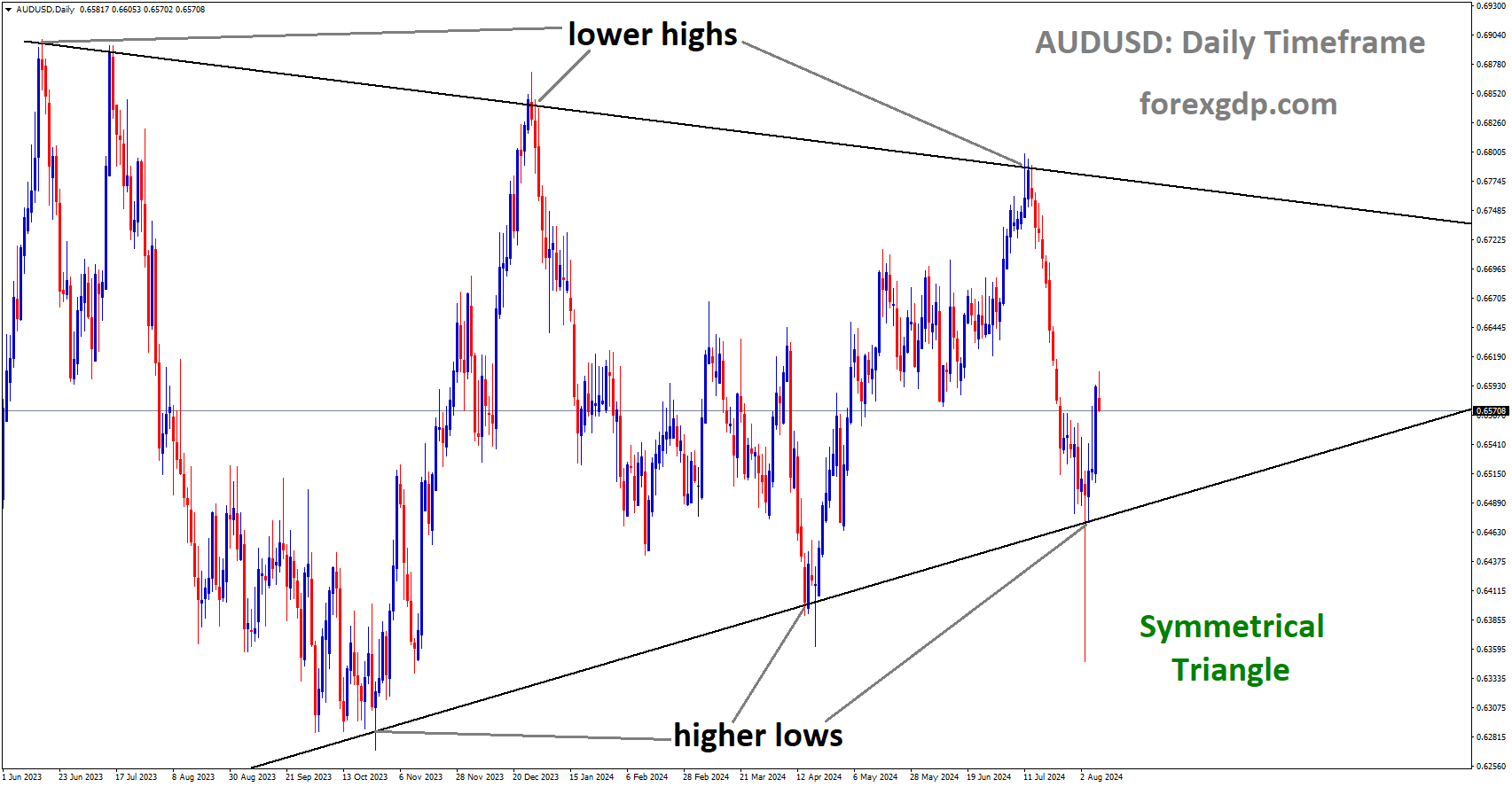
Aussie Dollar’s Struggle Continues Despite RBA’s Tough Talk
AUDUSD is moving in Symmetrical Triangle and market has rebounded from the higher low area of the pattern The Australian
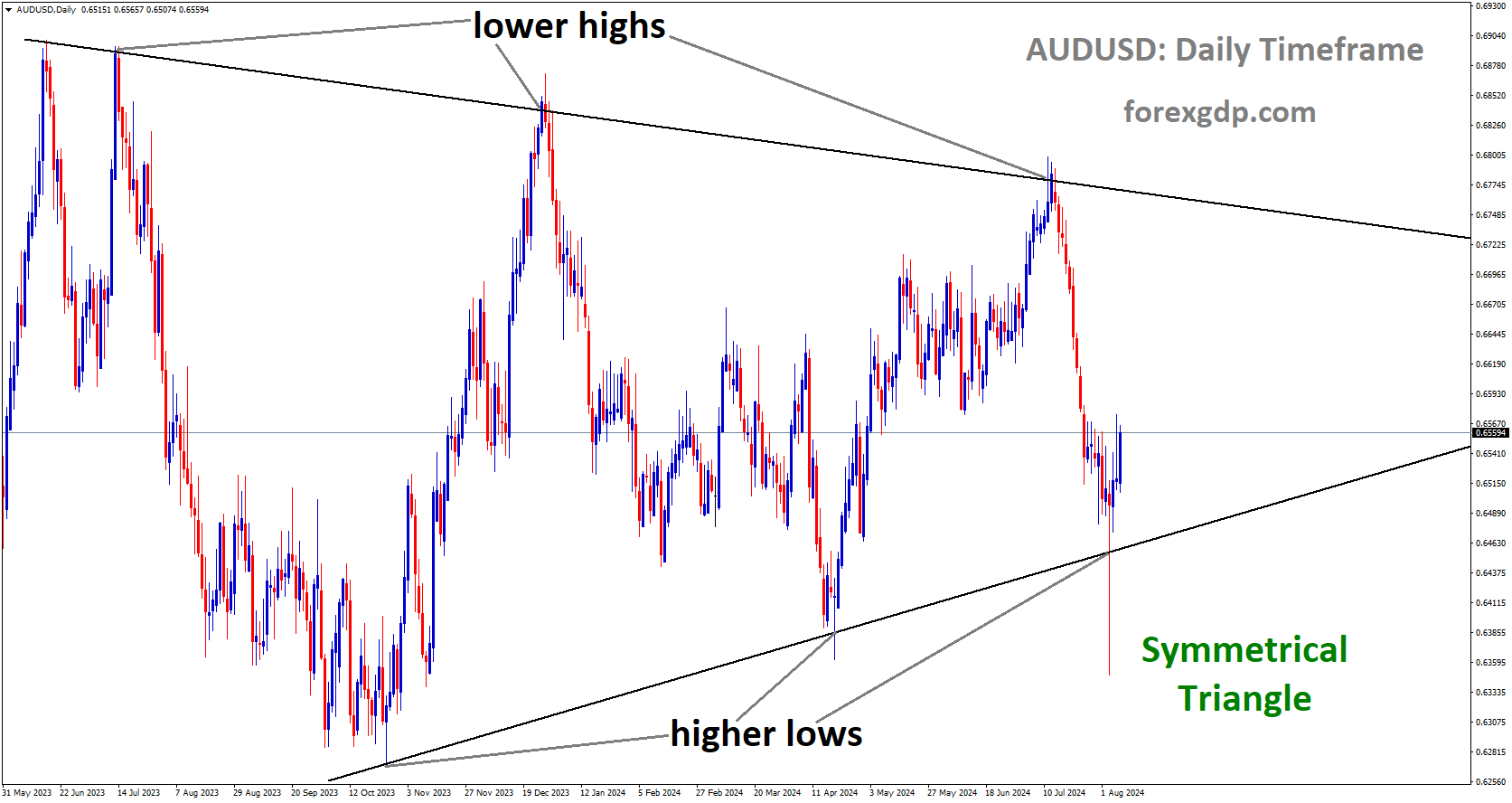
Aussie Dollar Gains Momentum on RBA’s Hawkish Hints
AUDUSD is moving in Symmetrical Triangle and market has rebounded from the higher low area of the pattern Australian Dollar

Australian Dollar Gains Momentum with RBA’s Hawkish Tone
AUDUSD is moving in Ascending channel and market has rebounded from the higher low area of the channel Why the
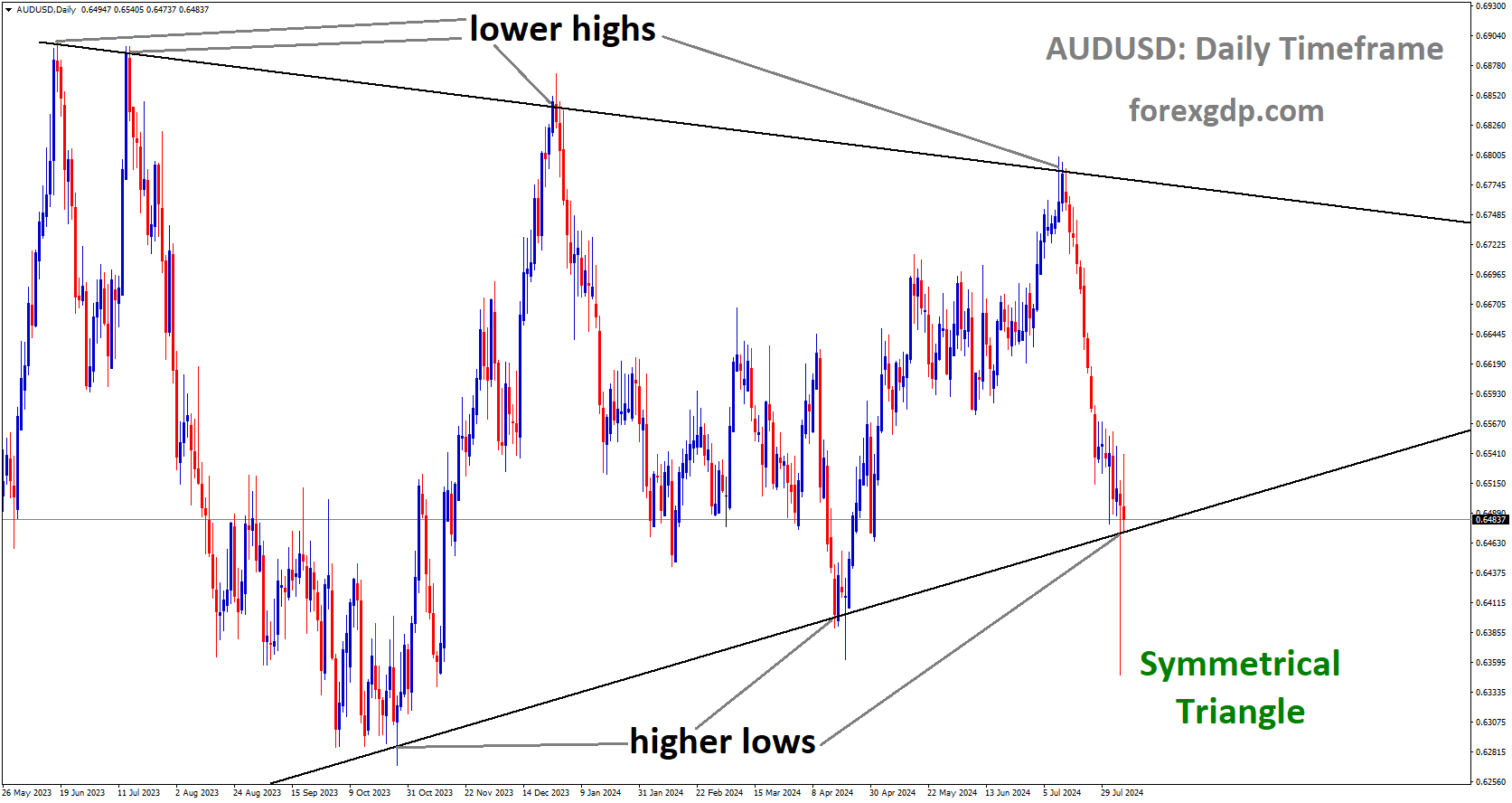
AUD/USD Retreats After Brief Surge on RBA News, Returns to 0.6500 Zone
AUDUSD is moving in Symmetrical Triangle and market has reached higher low area of the channel Why the AUD/USD Pair

